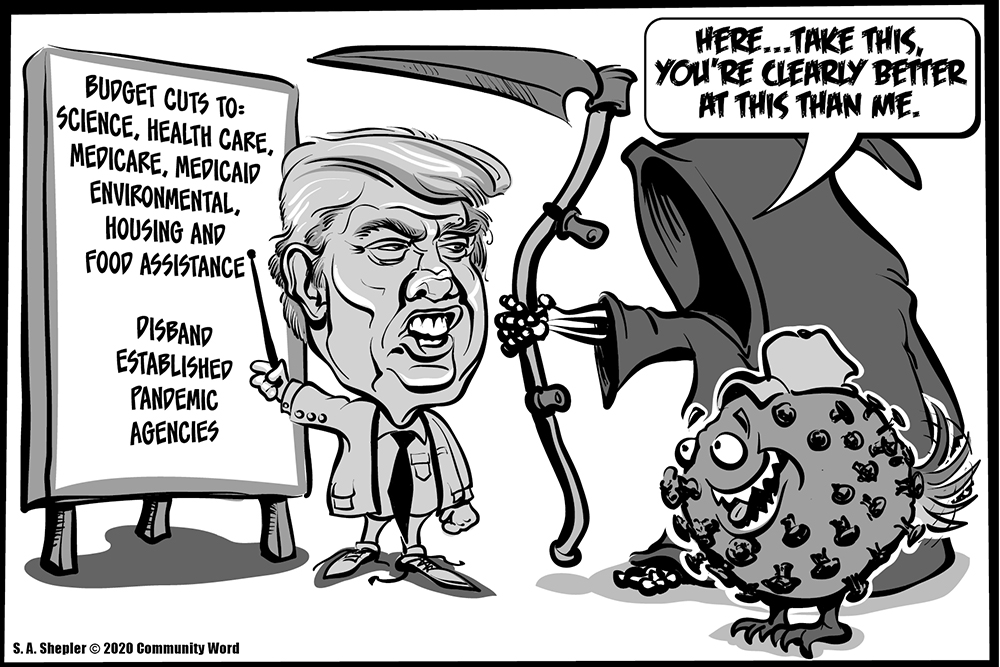There is something pathetic, ridiculous and depressing watching scores of people picketing the state capital in Michigan carrying assault weapons and protesting orders to stay home and wear a face mask in public.
But even more depressing is listening to an American president cheer them on, calling on them to “liberate” their state.
“These are very good people, but they are angry,” Trump tweeted.
Conflating constitutional individual rights with public health and safety is dangerous, flawed reasoning. But it fits a pattern of discrediting government, undermining science and justifying illogical conclusions in order to distract from real issues.
A New York Times editorial stated the decision to drop the case against Michael Flynn had little to do with Flynn and everything to do with discrediting the FBI. Casting doubt, eroding trust and second-guessing science are all part of an election year strategy.
Authorities globally and in America have a history of using public health to justify discrimination against minorities and immigrants. The safeguard against overreaching authority and arbitrary use of power is rigorous science informing public policy. But when resources for testing, surveillance and research are cut, –– effective public policy is jeopardized.
According to the American Public Health Association, Trump’s proposed budget with cuts to the Centers for Control and Prevention and the Department of Health and Human Resources would create a public health crisis.
“Despite increasing health threats, the White House is calling for slashing hundreds of millions of dollars from the country’s lead public health agencies,” states an article in The Nation’s Health.
According to the article, the president’s proposed budget for fiscal year 2021 calls for a cut of more than $693 million at the CDC and $742 million to programs at the Health Resources and Services Administration. Overall, the president’s budget proposes a 9% funding cut at the U.S. Department of Health and Human Services, a 26% cut at the U.S. Environmental Protection Agency, massive cuts in Medicare and Medicaid spending, and funding decreases for safety net programs such as food and housing assistance.
“This budget, put simply, is a disinvestment in the health of Americans,” said APHA Executive Director Georges Benjamin, MD.
Maybe most ironic is an $85 million cut to emerging and zoonotic infectious disease work. COVID-19 is a zoonotic infectious disease.
Hope is that Congress will shred this budget proposal.
But we have a history of inadequate funding for public health. Journalist Laurie Garrett told NYT columnist Frank Bruni that a symbol of inadequate funding for public health was clear during her time at Harvard University.
“The medical school is all marble, with these grand columns,” she said. “The school of public health is this funky building, the ugliest possible architecture, with the ceilings falling in.”
The tension and contested issues between public health policy and individual rights merit constant analysis, scrutiny and revisions. From battling tuberculosis and smallpox to STDs, HIV and SARS, strategies were developed, mistakes made and corrected, and transmissions were reduced.
The best, most successful strategies have been based on science, research and public understanding. That’s not happening with COVID-19. Instead we have miracle drug cures touted without scientific backing, we have irrational protest marches and hollow promises that COVID-19 is no worse than seasonal flu.
Now is the time to reinvest in public health and start respecting science and medicine because we already know a second wave of COVID-19 is percolating.
As Hugh Higgins, owner of Hearth restaurant on Prospect Road in Peoria Heights told the Journal Star: “Painful as all of this has been, I would rather stay closed and force the virus to go away faster than open too soon and watch it relapse.”
Countries doing the best combating COVID-19 include New Zealand, Taiwan, Finland, Norway, Denmark and Germany. Notice a pattern? Their leaders all respect science, they are methodical, pragmatic and logical. They rely on reason, not emotion, not military assault weapons.
And they are all women.

